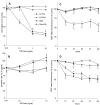Expression and regulation of CD97 in colorectal carcinoma cell lines and tumor tissues
- PMID: 12414513
- PMCID: PMC1850798
- DOI: 10.1016/S0002-9440(10)64443-4
Expression and regulation of CD97 in colorectal carcinoma cell lines and tumor tissues
Abstract
The expression of CD97, a member of the EGF-TM7 family with adhesive properties, is proportional to the aggressiveness and lymph node involvement in thyroid tumors. CD97 has never been systematically investigated in other tumors. First, we examined colorectal carcinoma cell lines (n = 18) for CD97 expression and regulation. All cell lines were CD97-positive. The level of CD97 in each line correlated with migration and invasion in vitro. This result was confirmed in CD97-inducible Tet-off HT1080 cells. Transforming growth factor-beta, which inhibits proliferation in transforming growth factor-beta-sensitive LS513 and LS1034 cells, down-regulated CD97 in these cell lines. Examining CD97 during sodium butyrate-induced cell differentiation of Caco-2 cells, we could demonstrate a CD97-decreasing effect. Second, we screened 81 colorectal adenocarcinomas by immunohistology for expression of CD97. Normal colorectal epithelium is CD97-negative. Seventy-five of 81 of the carcinomas expressed CD97. The strongest staining for CD97 occurred in scattered tumor cells at the invasion front compared to cells located within solid tumor formations of the same tumor. Carcinomas with more strongly CD97-stained scattered tumor cells showed a poorer clinical stage as well as increased lymph vessel invasion compared to cases with uniform CD97 staining. In summary, CD97 expression correlates with dedifferentiation, migration, and invasion in colorectal tumor cell lines. Moreover, more strongly CD97-stained tumor cells at the invasion front of colorectal carcinomas indicate the involvement of the molecule in tumor migration and invasion.
Figures





References
-
- McKnight AJ, Gordon S: The EGF-TM7 family: unusual structures at the leukocyte surface. J Leukoc Biol 1998, 63:271-280 - PubMed
-
- Hamann J, Eichler W, Hamann D, Kerstens HM, Poddighe PJ, Hoovers JM, Hartmann E, Strauss M, van Lier RA: Expression cloning and chromosomal mapping of the leukocyte activation antigen CD97, a new seven-span transmembrane molecule of the secretion receptor superfamily with an unusual extracellular domain. J Immunol 1995, 155:1942-1950 - PubMed
-
- Gray JX, Haino M, Roth MJ, Maguire JE, Jensen PN, Yarme A, Stetler-Stevenson MA, Siebenlist U, Kelly K: CD97 is a processed, seven-transmembrane, heterodimeric receptor associated with inflammation. J Immunol 1996, 157:5438-5447 - PubMed
-
- Baud V, Chissoe SL, Viegas-Pequignot E, Diriong S, N’Guyen VC, Roe BA, Lipinski M: EMR1, an unusual member in the family of hormone receptors with seven transmembrane segments. Genomics 1995, 26:334-344 - PubMed
-
- Lin HH, Stacey M, Hamann J, Gordon S, McKnight AJ: Human EMR2, a novel EGF-TM7 molecule on chromosome 19p13.1, is closely related to CD97. Genomics 2000, 67:188-200 - PubMed
Publication types
MeSH terms
Substances
LinkOut - more resources
Full Text Sources
Other Literature Sources
Medical
Molecular Biology Databases
Miscellaneous

